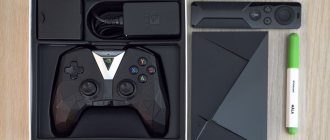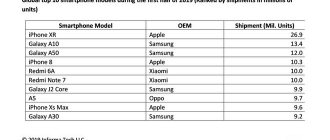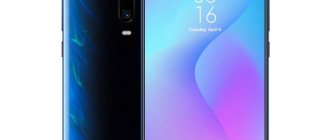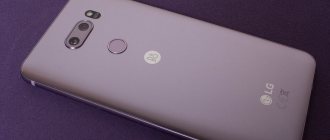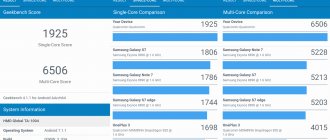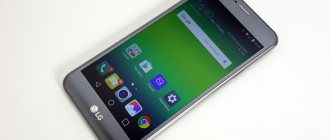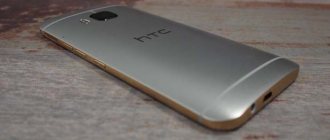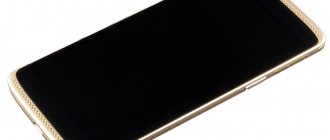What a beautiful!
The world of gadgets is depressing: phones are similar to each other, there is practically no difference. It's great that OPPO managed to come up with a beautiful device in its own style. Huge screen, thin frames, shiny back with shimmer. What a beautiful lollipop!
Gradient transitions look gorgeous, the body gets dirty with terrible force, but this is nonsense against the backdrop of such luxury. Perhaps the most beautiful smartphone of the year, very, very pleasant.
Screens in a frameless style are no longer surprising, but there is no “unibrow” here, and they managed to fit the earpiece in the usual place so that the quality of voice transmission does not suffer.
The build is perfect, the materials are excellent: curved Gorilla Glass 5 on the front and back, and a metal frame on the sides.
Sound
The new product received stereo speakers with Dolby Atmos technology: one is located at the bottom end of the case, the second is played by a conversational speaker. The volume reserve is very large, but at maximum values overload occurs: the sound becomes harsher. However, 60–70% volume is enough to watch videos on YouTube or play games.
Photo: Artyom Bagdasarov
There is no 3.5 mm audio jack here. The kit includes earbuds a la EarPods with a USB Type-C connection. They sound completely normal and are suitable for undemanding listeners.
The smartphone has a system of three microphones that can focus on the voice and suppress background noise. Voice transmission during calls is not satisfactory. But what you can find fault with is the vibration motor. The tactile feedback is a little rattling and not as pleasant as in the latest Samsung ones. Not to mention the iPhone with Taptic Engine.
He has a periscope camera!
I liked the hidden camera feature. Firstly, the simple shooting process looks very impressive: you click on the icon, start shooting, and before that a camera appears. It leaves quickly and smoothly, the latency is minimal for such a form factor, which is impressive.
Secondly, OPPO did not copy the protruding camera on the iPhone, as competitors do, but elegantly hid everything in the body.
Immediately the question is: will the camera break if dropped? It depends on your luck. We conducted such an experiment. We held the phone near our ear, imitating a conversation, and accidentally dropped the OPPO Find X, as if it had slipped out. The phone fell onto the sofa, during which time the camera managed to slide back into place. Just like a turtle falling into its shell at the sight of danger.
OPPO said that the slider camera can withstand 300,000 operations, which is enough for five years of active use of the phone. I can say from myself that the area around the camera collects fine dust and debris; you should not wash the phone under the tap. Are you planning a vacation in hot countries? Beware of sandstorms.
Does the phone drain faster due to the moving part of the camera? To be honest, I didn’t take any special measurements, but I didn’t notice any significant difference compared to regular phones.
I have no questions about the shooting quality of the OPPO Find X. A phone with two Sony modules of 16 and 20 megapixels, it has an advanced front camera and its own artificial intelligence for scene recognition. The bells and whistles are, in general, common for a flagship, but this camera that pops out at the moment of shooting is the most unusual thing that can be in a phone. Even my wife took the smartphone for use for a few days; she really liked the processing of the photos. Automation will add a glow and rejuvenate the skin; making portraits and self-portraits is a pleasure. And in other modes, the camera works great, except that at night the shots don’t always come out perfect, but this depends on the shooting conditions and the skills of the photographer himself.
Fast and reliable protection
The camera helps protect the data on your phone. The OPPO Find X has a facial recognition function: there is a combination of an IR camera, IR illumination and a projection of 15,000 points. It sounds like a bid for success, but it is true: the system works quickly. Moreover, this takes into account the fact that the camera must leave the body, recognize the face and hide back. We compared it with iPhone X on iOS 12, so the system works slower there.
The phone charges very quickly
Devices are becoming cooler and more powerful, but all this joy turns to dust when the battery runs out. What to do? Manufacturers took two paths. Some increase the capacity of built-in batteries, offering smartphones with high-capacity batteries. Others are working to speed up the charging process.
In the case of OPPO Find X, we get a 3400 mAh battery and fast charging feature. It amazed me; I have never seen such speeds in phones, when the battery is literally gaining strength before our eyes. VOOC charging fully charges your phone in 35-40 minutes. Typically, during this time, phones are charged by 50–60%, and a full cycle takes an hour and a half. And then in 5 minutes at the outlet it’s already 10%. It's amazing how fast it is.
The magic only works when using the original charger and original cable. Moreover, as I understand it, it is not yet possible to buy additional charging in Russia. Alas, it’s a pity: you could buy a unit for work or for the dacha as a backup. If you use “regular” charging, you won’t get such amazing speed.
Specifications
| Platform | Android 10, Color OS 7.1 firmware |
| Display | 6.7 inches, 3,168 × 1,440 pixels, AMOLED, 120 Hz, 513 ppi, Always On, HDR10+ |
| Chipset | Qualcomm Snapdragon 865, Adreno 650 video accelerator |
| Memory | RAM – 12 GB LPDDR5, ROM – 256 GB UFS 3.0 |
| Connection | 2 × nanoSIM, Wi-Fi 6, GPS, GLONASS, Bluetooth 5.1, NFC, GSM / GPRS / EDGE / LTE |
| Sound | Stereo speakers with Dolby Atmos, |
| Battery | 2 × 2 100 mAh, Super VOOC fast charging |
| Peculiarities | Protection against moisture and dust according to IP54 standard |
| Dimensions | 164 × 75 × 7.9 mm |
| Weight | 192 g |
What's missing here?
It’s convenient to pay for purchases with your phone or watch, so you expect this function to be everywhere. In China, NFC is not held in high esteem; QR codes reign there, but they have not taken root in Russia. Unfortunately, OPPO Find X did not include NFC.
There is also no protection from dust and moisture, although taking into account the concept of the device, where the camera moves out of the body, there can be no question of complete protection.
There is also no 3.5 mm port; you can connect regular headphones only through an adapter. I don’t see a problem with this: it’s more convenient to listen to music through Bluetooth headphones, and when you buy a phone for 70 thousand, it’s somehow strange to worry about this. I used a Sony SBH90C paired with OPPO Find X, it’s a great thing, I’ll write about it too.
I thought that there would be a place for wireless charging in the glass case, but there is none.
Review of the Oppo Find X smartphone with an unusual sliding panel
This summer, the Chinese company Oppo presented its unusual mobile product at the Louvre in Paris - the flagship Find X smartphone with an innovative camera, Super VOOC fast charging technology and support for 3D calls on the 5G network. In addition, Find X became the first smartphone released in the Find line in the last four years. Thus, the new model marked the revival of the Find line, the hallmark of which has always been the introduction of the most advanced technologies.
Key Features of Oppo Find X
- SoC Qualcomm Snapdragon 845, 8 cores (4 × Kryo 385 @2.8 GHz + 4 × Kryo 385 @1.8 GHz)
- GPU Adreno 630
- Operating system Android 8.1, ColorOS 5.1
- Touch display Super AMOLED 6.4″, 2340×1080 (19.5:9)
- Random access memory (RAM) 8 GB, internal memory 128/256 GB
- No microSD support!
- Nano-SIM support (2 pcs.)
- GSM/WCDMA networks
- LTE Cat.18 networks FDD B1/2/3/4/5/7/8/12/13/17/18/19/20/25/26/28/29/32/66, TD B34/38/39 /40/41
- Wi-Fi 802.11a/b/g/n/ac (2.4 and 5 GHz)
- Bluetooth 5.0
- NFC is missing!
- Dual GPS, A-GPS, Glonass, BDS
- USB Type-C, USB OTG
- There is no 3.5mm audio output!
- Main camera 20 MP, f/2.0 + 16 MP, f/2.0; 4K video
- Front camera 25 MP, f/2.0
- Proximity and lighting sensors, magnetic field, accelerometer
- 3400 mAh battery, Super VOOC fast charging
- Dimensions 157×74×9.6 mm
- Weight 186 g
| Average price of Oppo Find X (8/128 GB) | Average price of Oppo Find X (8/256 GB) |
| find out prices | find out prices |
| Oppo Find X (8/128GB) retail offers | Oppo Find X (8/256GB) retail offers |
| find out the price | find out the price |
Appearance and ease of use
The Oppo Find X has a luxurious, eye-catching design that is somewhat reminiscent of Samsung's latest "borderless" Galaxy products. Here, the same strongly curved side edges of the glass panels smoothly merge with an elegant metal frame that changes its width from the top and bottom ends to the sides. The creators themselves call it “panoramic design.”
Perhaps this is one of the disadvantages: the side edges, narrowed to the point of being pointed, although streamlined, are not held very securely in the hand due to the small contact area. A heavy and large smartphone with such slippery surfaces simply turns by itself in the palm of your hand; a case is definitely needed here.
And since any kind of case won’t fit here due to the retractable upper part of the case, it’s good that they included their own in the kit. Although it is not very beautiful, and besides, it is hard, but at least it does not prevent the top from moving out.
The front and rear cameras, along with the flash and sensors, are hidden in a sliding panel. It automatically leaves as soon as the camera is activated or authorization occurs using the owner’s face. You can push it back manually - or it will retract itself when the camera turns off.
It’s curious: the sensor of a smartphone falling from a height of human height manages to react and push the camera inside in just 0.6 seconds, so this happens even before it hits the ground.
Overall, the decision is controversial. Shooting videos and taking photographs while holding the smartphone in a horizontal position is quite unusual; this entire structure has to be held in a special way. But over time, of course, you get used to it.
On the front side, all the usual elements usually located above the screen are also hidden in a sliding panel. What is all this for? According to the creators, this ensures a sophisticated appearance of the case and a convenient placement of the smartphone in the hand. After all, the screen now occupies a record 93.8% of the area of the front part of the smartphone.
Accordingly, there is no LED indicator here at all, and a special technology was invented to operate the proximity sensor. That is, the sensor itself is also located in the retractable part, but during a telephone conversation the screen is still blocked in a clever way when brought to the ear. It is described as follows: “The sensor detects the approach of the smartphone to the ear and starts the function of automatically turning off the screen. An infrared sensor, which is located under the screen, detects the distance between the ear and the screen during a phone call, and when this distance increases, the screen is activated again. "Oppo engineers tested the sensor in a variety of conditions to ensure it performs as well as traditional distance sensors." The developers even posted a warning on the website: “Any film or opaque cover may block light passing through the sensor.”
In total, the Find X hidden module contains (from different sides): a light sensor, an infrared camera, a proximity sensor, a speaker, a 3D face recognition sensor, a dot projector, as well as front and main dual cameras.
The tray for two Nano-SIM cards is embedded in the bottom end, and it is not hybrid; you cannot insert a memory card into it. The cards are attached in a special compact way, back to back, with the contacts facing outward. The tray cover has a rubberized gasket, although the manufacturer does not officially indicate the presence of water protection anywhere.
The main speaker is located at the bottom end, where the USB Type-C connector is also located. The speakers do not work in stereo mode. The smartphone does not have a 3.5 mm audio output for headphones.
Oppo Find X is available in two colors, they are called “Ruby Bordeaux” and “Indigo Sapphire”, in both cases the gradient transition from dark to light is clearly visible. Both shimmer in the rays and look equally luxurious.
Screen
Oppo Find X is equipped with a 6.4-inch Super AMOLED display with a resolution of 2340×1080, covered with Gorilla Glass 5. The physical dimensions of the screen are 68×148 mm, the frame is as thin as possible, approximately 2-3 mm on each side.
A detailed examination using measuring instruments was carried out by the editor of the “Monitors” and “Projectors and TV” sections Alexey Kudryavtsev . Here is his expert opinion on the screen of the sample under study.
The front surface of the screen is made in the form of a glass plate with a mirror-smooth surface that is scratch-resistant. Judging by the reflection of objects, the anti-glare properties of the screen are better than those of the Google Nexus 7 (2013) screen (hereinafter simply Nexus 7). For clarity, here is a photo in which a white surface is reflected in the switched off screens (on the left - Nexus 7, on the right - Oppo Find X, then they can be distinguished by size):
The screen of the Oppo Find X is slightly darker (photo brightness is 107 versus 113 for the Nexus 7, glare curved edges are not taken into account). The ghosting of reflected objects on the Oppo Find X's screen is very weak, indicating that there is no air gap between the layers of the screen. Due to the smaller number of boundaries (glass/air type) with very different refractive indices, such screens look better in conditions of intense external illumination, but their repair in the case of cracked external glass is much more expensive, since the entire screen has to be replaced. The outer surface of the screen has a special oleophobic (grease-repellent) coating (better in efficiency than that of the Nexus 7), so fingerprints are removed more easily and appear at a slower rate than with regular glass.
With manual brightness control and when the white field was displayed in full screen, the maximum brightness value was about 410 cd/m². You also need to take into account that in this case, the smaller the white area on the screen, the lighter it is, that is, the actual maximum brightness of the white areas will almost always be higher than the specified values. As a result, taking into account the excellent anti-glare properties, readability during the day in the sun should be at a good level. The minimum brightness value is 1.7 cd/m², so in complete darkness the brightness can be reduced to a comfortable value. There is automatic brightness adjustment based on the light sensor (it is located on the upper right side). However, this function does not work well: for example, after getting up in bright light, the screen brightness remains maximum even in complete darkness and even after putting the smartphone into standby mode and then turning it on. At the same time, the light sensor itself works properly and produces values close to real ones. We hope that automatic brightness adjustment will work normally after updating the system.
At any brightness level there is significant modulation with a frequency of 60 or 240 Hz. The figure below shows brightness (vertical axis) versus time (horizontal axis) for several brightness settings:
It can be seen that at maximum and average brightness the modulation amplitude is not very large; as a result, there is no visible flicker. However, with a strong decrease in brightness, modulation appears with a large relative amplitude; its presence can already be seen in a test for the presence of a stroboscopic effect or simply with rapid eye movement. Depending on individual sensitivity, this flickering may cause increased fatigue.
This screen uses a Super AMOLED matrix - an active matrix on organic light-emitting diodes. A full-color image is created using subpixels of three colors - red (R), green (G) and blue (B), but there are half as many red and blue subpixels, which can be referred to as RGBG. This is confirmed by a fragment of a microphotograph:
For comparison, you can see the gallery of microphotographs of screens used in mobile technology.
In the fragment above you can count 4 green subpixels, 2 red (4 halves) and 2 blue (1 whole and 4 quarters), and by repeating these fragments, you can lay out the entire screen without breaks or overlap. For such matrices, Samsung introduced the name PenTile RGBG. The manufacturer calculates the screen resolution based on the green subpixels; based on the other two, it will be two times lower. Of course, there is some unevenness of contrast borders and other artifacts. However, due to the high resolution, they only minimally affect the image quality.
The screen has excellent viewing angles. True, the white color, when deviated even at small angles, alternately acquires a barely visible blue-green and pinkish tint, but the black color remains simply black at any angle. It is so black that the contrast setting is not applicable in this case. For comparison, here are photographs in which identical images are displayed on the screens of Oppo Find X and Nexus 7, while the screen brightness is initially set to approximately 200 cd/m², and the color balance on the camera is forcibly switched to 6500 K.
There is a white field perpendicular to the screens:
The uniformity of brightness and color tone of the white field is very good. There is a subtle darkening towards the curved edges, but the Nexus 7's LCD screen still has much poorer white field uniformity.
And a test picture:
The colors on the Oppo Find X's screen are oversaturated (note the tomatoes, bananas, napkin and face shade) and the color balance is slightly off. Let us remind you that the photograph cannot serve as a reliable source of information about the quality of color rendering and is provided only for conditional visual illustration. In particular, the pronounced reddish tint of the white and gray fields present in photographs of the Oppo Find X screen is visually absent when viewed perpendicularly, as confirmed by hardware tests using a spectrophotometer. The reason is that the spectral sensitivity of the camera sensor does not exactly match this characteristic of human vision.
Now at an angle of approximately 45 degrees to the plane and to the side of the screen. White field:
The brightness at an angle for both screens has decreased noticeably (to avoid strong darkening, the shutter speed has been increased compared to previous photos), but in the case of the Oppo Find X the drop in brightness is less. As a result, with formally the same brightness, the Oppo Find X screen visually looks much brighter (compared to LCD screens), since you often have to look at the screen of a mobile device from at least a slight angle.
And a test picture:
It can be seen that the colors have not changed much on both screens and the brightness of the Oppo Find X at an angle is noticeably higher. However, the darkening on the far curved edge and the lightening on the near one are well expressed.
Switching the state of the matrix elements is almost instantaneous, but at the turn-on edge there may be a step with a width of approximately 17 ms (which corresponds to a screen refresh rate of approximately 60 Hz). For example, this is what the dependence of brightness on time looks like when moving from black to white and back:
In some conditions, the presence of such a step can lead to plumes trailing behind moving objects. However, dynamic scenes in films on OLED screens are distinguished by high clarity and even some “jerky” movements.
A gamma curve constructed using 32 points with equal intervals based on the numerical value of the shade of gray showed that there is no significant blockage either in the highlights or in the shadows. The exponent of the approximating power function is 2.22, which is quite a bit higher than the standard value of 2.2. In this case, the real gamma curve deviates slightly from the power-law dependence:
Let us recall that in the case of OLED screens, the brightness of image fragments dynamically changes in accordance with the nature of the displayed image - it decreases for generally light images. As a result, the resulting dependence of brightness on hue (gamma curve) most likely slightly does not correspond to the gamma curve of a static image, since the measurements were carried out with sequential display of shades of gray on almost the entire screen.
The color gamut is much wider than sRGB and even slightly wider than DCI-P3:
The spectra of the components are very well separated, which allows for wide coverage:
Note that on screens with a wide color gamut, without appropriate correction, the colors of regular images optimized for sRGB devices appear unnaturally saturated.
By default, the color temperature of the white and gray fields is high, about 7500 K, but in the screen settings there is a color temperature adjustment slider:
After correction (as in the picture above), the balance becomes better: the color temperature is closer to 6500 K, while in a significant portion of the gray scale this parameter does not change very much, which improves the visual perception of color balance. The deviation from the blackbody spectrum (ΔE) remains below 10 units, which is considered a good indicator for a consumer device:
(The darkest areas of the gray scale can be ignored, since color balance there is not very important, and the error in measuring color characteristics at low brightness is large.)
Of course, there is a fashionable mode with reduced intensity of the blue component:
Let us recall that, in principle, bright light can lead to disruption of the daily (circadian) rhythm (see the article about the iPad Pro with a 9.7-inch display), but everything can be solved by adjusting the brightness to a comfortable level, and distorting the color balance, reducing the contribution of blue , makes absolutely no sense.
Let's summarize. The screen has a fairly high maximum brightness and has excellent anti-glare properties, so the device can be used outdoors even on a sunny summer day. In complete darkness, the brightness can be reduced to a comfortable value. Unfortunately, the mode with automatic brightness adjustment in the current firmware does not work adequately. The advantages of the screen include an effective oleophobic coating and good color balance (after a small correction). At the same time, let us recall the general advantages of OLED screens: true black color (if nothing is reflected in the screen), good uniformity of the white field, noticeably less than that of LCDs, and a drop in image brightness when viewed at an angle. Disadvantages include an overly wide color gamut and screen flickering at low brightness. For users who are particularly sensitive to flicker, this may cause increased fatigue. Separately, we note that from the point of view of image quality, curved edges are only harmful, since they introduce color tone distortions and change the brightness at the edges of the picture, and in ambient light conditions they lead to inevitable glare along at least one long side of the screen. However, overall the screen quality is high.
Camera
The front camera of Oppo Find X has a 25 MP sensor resolution and an F2.0 aperture lens. The developers call it a “smart 3D camera” that can analyze the face, nose, eyes and other features to make the pictures look more natural. The front camera does not have an LED flash, but the description calls the illumination from the screen “a three-dimensional lighting technique for artistic portraits.” That is, the screen illuminates the face before shooting, flashing several times with different shades of color.
There is a portrait mode with background blur, which the camera does well. And in general, the shooting quality is excellent: the image is bright, detailed, with correct color rendition and good sharpness.
The rear camera uses two modules with a resolution of 20 MP and 16 MP, both lenses have an f/2.0 aperture. The camera has optical image stabilization and 5x hybrid zoom.
This year, it has become fashionable for manufacturers to use so-called “artificial intelligence” (AI) everywhere, and this smartphone also uses it. AI algorithms allow the camera to recognize objects and landscapes (artificial intelligence technology identifies 800 different scenes), as well as “manage” the depth of field after shooting.
Examples of shooting with the main camera:
The camera didn't surprise us with anything. Using wide-angle lenses in smartphones (where they cannot be changed on the fly) makes sense, but one must understand that a significant part of the frame in this case will have distorted geometry, and the very edges will also radically lose sharpness. If the owner of Oppo Find X wants his pictures to fit entirely on the screen of his smartphone, then he will have to shoot in a very “non-canonical” mode with an aspect ratio of 19.5:9, and this is not at all “photographic” 4:3. In addition, when the lighting is not very bright, noise is already clearly visible in the pictures, and in many cases, incomprehensible areas of blur. At the same time, the camera beautifully blurs the background, confidently shoots macro and provides a quite decent optical zoom of 2× (it is better, as usual, not to use hybrid zoom when the shooting result is “closer” using digital zoom). In short, the camera is good, but far from flagship, and for an expensive smartphone that makes a big show out of getting the camera ready for combat, the result does not look impressive.
Video can be shot in 4K format at 30 fps, there is slow motion shooting in a maximum resolution of 1080p, other parameters are not specified. Video is always encoded in H.264, there is no choice of codec. It’s also not entirely clear whether optical stabilization works for video shooting, but in practice you don’t feel it at all, and there are no options for this in the settings. The video quality itself is not bad, but shooting handheld on the go without stabilization is useless. In addition, there is a standard disease of most Asian cameras - unnatural, oversaturated, caustic paints. The sound is recorded clearly, and the noise reduction system works adequately.
- Video No. 1 (45 MB, 3840× [email protected] fps, H.264, AAC)
- Video No. 2 (87 MB, 3840× [email protected] fps, H.264, AAC)
- Video No. 3 (84 MB, 3840× [email protected] fps, H.264, AAC)
- Video No. 4 (84 MB, 1920× [email protected] fps, H.264, AAC)
- Video No. 5 (84 MB, 1920×1080, slo-mo, H.264, AAC)
Telephone and communications
The modem built into the Qualcomm Snapdragon 845 SoC supports many LTE frequency bands, including all three LTE FDD bands used in Russia (Band 3, 7, 20). In practice, within the city limits of the Moscow region, the device demonstrates reliable operation in wireless networks, does not lose connection, and quickly restores connection after a forced interruption.
There are also no complaints about the operation of the Wi-Fi module (2.4 and 5 GHz, there is support for 802.11ac), Bluetooth is version 5.0, but again there is no NFC module.
The navigation module works with GPS (with A-GPS), and with the domestic Glonass, and the Chinese Beidou. The first satellites, even during a cold start, are detected quickly, within the first seconds, and the positioning accuracy does not cause any complaints. Naturally, there is a magnetic compass, necessary for navigation programs.
The phone application supports Smart Dial, that is, while dialing a phone number, a search is immediately carried out by the first letters in contacts. Methods for setting up sorting and display of contacts are standard for the Android interface. VoLTE support is available. The vibration alert is not the strongest.
The hardware platform allows the smartphone to support both SIM cards in 4G mode at the same time. This way, the voice SIM card will work in 4G standby mode even if another card is assigned to 4G data. The cards operate in Dual SIM Dual Standby mode, there is only one radio modem.
Software and multimedia
As a software platform, Oppo Find X uses Android OS version 8.1, but with its own shell. The interface is typically Chinese: it is clumsily designed, has a maximum number of settings, very wide support for gestures - everything that Asian users love and European ones turn away from. A close relative of Vivo offers a similar interface in its smartphones for the Russian market, and, obviously, both manufacturers will have to reconsider this point, because the popularity of such shells oversaturated with settings in our country is low; most users are very happy to accept the option with “pure Android” - Android One .
Find X features facial recognition technology that uses structured light to identify a face. Thanks to a laser generator that projects more than 15 thousand points onto the human face, the mechanism creates a reliable and complete three-dimensional model of the user's face. This allows you to accurately identify the user and instantly recognize his face for unlocking. According to the developers, the technology is 20 times more reliable than fingerprint identification.
Oppo Find X sounds good: both in headphones and even through a loudspeaker, the sound is rich, thick and quite clear. The speakers do not work in a stereo pair. There is no FM radio, the voice recorder demonstrates good quality, and is quite suitable for recording seminars and lectures.
Performance
Oppo Find X operates on the flagship Qualcomm Snapdragon 845 single-chip system. The chip is manufactured using a 10-nanometer process technology. The SoC configuration includes two clusters of four Kryo 385 processor cores: with a frequency of up to 2.8 GHz (custom Cortex-A75) and with a frequency of up to 1.8 GHz (custom Cortex-A55). The amount of RAM is 8 GB, the storage capacity is 128 or 256 GB. Of the 256 GB, 225 are available to the user. There is no option to install a memory card, but connecting flash drives in USB OTG mode is supported.
Qualcomm Snapdragon 845 is the flagship platform of the market leader in mobile SoCs, one of the most powerful solutions for smartphones. The hero of the review demonstrates maximum performance both in benchmarks and in real use; in this regard, there are no obstacles for him. All tested games, including Modern Combat 3, Mortal Kombat X, Injustice 2, run confidently without the slightest slowdown. The smartphone certainly has a significant headroom for future updates.
Testing in comprehensive tests AnTuTu and GeekBench:
For convenience, we have compiled all the results we obtained when testing the smartphone in the latest versions of popular benchmarks into tables. The table usually adds several other devices from different segments, also tested on similar latest versions of benchmarks (this is done only for a visual assessment of the obtained dry figures). Unfortunately, within the framework of one comparison it is impossible to present the results from different versions of benchmarks, so many worthy and relevant models remain “behind the scenes” - due to the fact that they once passed the “obstacle course” on previous versions of test programs.
| Oppo Find X (Qualcomm Snapdragon 845) | Huawei P20 Pro (HiSilicon Kirin 970) | Samsung Galaxy Note 9 (Samsung Exynos 9810) | Meizu Pro 7 Plus (MediaTek Helio X30) | |
| AnTuTu (v7.x) (bigger is better) | 282848 | 209585 | 243281 | 143077 |
| GeekBench (bigger is better) | 2295/7588 | 1906/6775 | 3708/9117 | 1415/541 |
Testing the graphics subsystem in gaming tests 3DMark, GFXBenchmark and Bonsai Benchmark:
When testing in 3DMark, the most powerful smartphones now have the ability to run the application in Unlimited mode, where the rendering resolution is fixed at 720p and VSync is disabled (which can cause the speed to rise above 60 fps).
| Oppo Find X (Qualcomm Snapdragon 845) | Huawei P20 Pro (HiSilicon Kirin 970) | Samsung Galaxy Note 9 (Samsung Exynos 9810) | Meizu Pro 7 Plus (MediaTek Helio X30) | |
| 3DMark Ice Storm Sling Shot ES 3.1 (bigger is better) | 4428 | 2963 | 3348 | 1826 |
| 3DMark Sling Shot Ex Vulkan (bigger is better) | 3456 | 2918 | 2840 | 1217 |
| GFXBenchmark Manhattan ES 3.1 (Onscreen, fps) | 45 | 39 | 25 | 14 |
| GFXBenchmark Manhattan ES 3.1 (1080p Offscreen, fps) | 52 | 39 | 45 | 22 |
| GFXBenchmark T-Rex (Onscreen, fps) | 60 | 60 | 60 | 52 |
| GFXBenchmark T-Rex (1080p Offscreen, fps) | 142 | 108 | 146 | — |
Testing in browser cross-platform tests:
As for benchmarks for assessing the speed of the javascript engine, you should always make allowance for the fact that their results significantly depend on the browser in which they are launched, so the comparison can only be truly correct on the same OS and browsers, and this is possible during testing not always. For Android OS, we always try to use Google Chrome.
| Oppo Find X (Qualcomm Snapdragon 845) | Huawei P20 Pro (HiSilicon Kirin 970) | Samsung Galaxy Note 9 (Samsung Exynos 9810) | Meizu Pro 7 Plus (MediaTek Helio X30) | |
| Mozilla Kraken (ms, less is better) | 3144 | 3841 | 2687 | 5106 |
| Google Octane 2 (bigger is better) | 13481 | 9311 | 15042 | 8341 |
| JetStream (bigger is better) | 65 | 65 |
AndroBench memory speed test results:
Thermal photographs
Below is a thermal image of the rear surface obtained after 10 minutes of running the battery test in the GFXBenchmark program:
The heating is located slightly above the center and closer to the right edge, which apparently corresponds to the location of the SoC chip. According to the heat camera, the maximum heating was 39 degrees (at an ambient temperature of 24 degrees), this is the average heating in this test for modern smartphones.
Playing video
To test the omnivorous nature of video playback (including support for various codecs, containers and special features, such as subtitles), we used the most common formats, which make up the bulk of the content available on the Internet. Note that for mobile devices it is important to have support for hardware video decoding at the chip level, since it is most often impossible to process modern options using processor cores alone. Also, you shouldn’t expect a mobile device to decode everything, since the leadership in flexibility belongs to the PC, and no one is going to challenge it. All results are summarized in a table.
| Format | Container, video, sound | MX Video Player | Standard player |
| 1080p H.264 | MKV, H.264, 1920×1080, 24 fps, AAC | plays normally | plays normally |
| 1080p H.264 | MKV, H.264, 1920×1080, 24 fps, AC3 | plays normally | plays without sound |
| 1080p H.265 | MKV, H.265, 1920×1080, 24 fps, AAC | plays normally | plays normally |
| 1080p H.265 | MKV, H.265, 1920×1080, 24 fps, AC3 | plays normally | plays without sound |
Further testing of video playback was performed by Alexey Kudryavtsev .
This device apparently does not support DisplayPort Alt Mode for USB Type-C - outputting image and sound to an external device when connected to a USB port - which was discovered using the Tronsmart CTHA1 adapter. Therefore, we had to limit ourselves to testing the output of video files on the screen of the device itself.
To do this, we used a set of test files with an arrow and a rectangle moving one division per frame (see “Method for testing video playback and display devices. Version 1 (for mobile devices)”). Screenshots with a shutter speed of 1 s helped determine the nature of the output of frames of video files with various parameters: the resolution varied (1280 by 720 (720p), 1920 by 1080 (1080p) and 3840 by 2160 (4K) pixels) and frame rate (24, 25, 30, 50 and 60 fps). In the tests we used the MX Player video player in the “Hardware” mode. The test results are summarized in the table:
| File | Uniformity | Passes |
| 4K/60p (H.265) | Great | No |
| 4K/50p (H.265) | Great | No |
| 4K/30p (H.265) | Great | No |
| 4K/25p (H.265) | Great | No |
| 4K/24p (H.265) | Great | No |
| 4K/30p | Great | No |
| 4K/25p | Great | No |
| 4K/24p | Great | No |
| 1080/60p | Great | No |
| 1080/50p | Great | No |
| 1080/30p | Great | No |
| 1080/25p | Great | No |
| 1080/24p | Great | No |
| 720/60p | Great | No |
| 720/50p | Great | No |
| 720/30p | Great | No |
| 720/25p | Great | No |
| 720/24p | Great | No |
Note: If both columns Uniformity and Skips have green ratings, this means that, most likely, when watching films, artifacts caused by uneven alternation and skipping of frames will either not be visible at all, or their number and visibility will not affect comfort viewing. Red marks indicate possible problems with playback of the corresponding files.
According to the criterion of frame output, the quality of playback of video files on the screen of the smartphone itself is very good, since frames or groups of frames can (but are not required) be output with uniform alternation of intervals and without gaps. When playing video files with a resolution of 1920 by 1080 pixels (1080p), the image of the video file itself is displayed one to one pixel by pixel, exactly at the height of the screen (in landscape orientation) and in true Full HD resolution. At the same time, the features of PenTile appear: the vertical world is pixelated into a grid, and the horizontal world is slightly blurred. However, the described artifacts are observed only on test worlds; they are absent on real frames. The brightness range displayed on the screen corresponds to the standard range of 16-235: in the shadows, only a couple of shades merge with black, but in the highlights all gradations of shades are displayed. Note that this smartphone has support for hardware decoding of H.265 files with a color depth of 10 bits per color, while output to the screen is carried out with fewer visible gradients than in the case of an 8-bit file.
Battery life
The smartphone received a non-removable 3400 mAh battery. The device shows good results in all tests, certainly no worse than its competitors of the same level. In real life, the smartphone confidently survives an overnight charge.
Testing has traditionally been carried out at the usual level of power consumption without using power saving functions, although the device has them.
| Battery capacity | Reading mode | Video mode | 3D Game Mode | |
| Oppo Find X | 3400 mAh | 16:00 | 13:00 | 3:00 am |
| Samsung Galaxy Note 9 | 4000 mAh | 18:00 | 13:00 | 3 hours 45 minutes |
| Huawei P20 Pro | 4000 mAh | 18:00 | 12:00 pm | 3:00 am |
| Meizu Pro 7 Plus | 3500 mAh | 14:10 | 10:00 am | 3 hours 20 minutes |
Continuous reading in the FBReader program (with a standard, light theme) at a minimum comfortable brightness level (brightness was set to 100 cd/m²) lasted 16 hours until the battery was completely discharged, and when continuously watching videos in high quality (1080p) at the same level brightness via a home Wi-Fi network, the device operates for up to 13 hours. In 3D gaming mode, the smartphone can work for up to 3 hours, depending on the specific game.
The smartphone supports fast charging with its own Super VOOC Flash Charge technology, which allows you to fully charge the device in just 35 minutes. And this is true, our test unit was fully charged in just 40 minutes from the included charger, something that no smartphone we have seen before could achieve even close. Charging begins with a current of 3 A at a voltage of 8 V, but it’s not just a matter of current. According to company representatives, the smartphone has two parallel batteries built in, which are charged in a special way at the same time, that is, the overall charging process is not linear.
Bottom line
Oppo Find X has already been officially presented on the Russian market; the price for the older version with 256 GB of memory reaches 70 thousand rubles. We don’t officially have a version with 128 GB on the market yet, but even from unofficial suppliers such a model is not cheap - about 60 thousand. Even with the most powerful and best Qualcomm platform on the market and support for all the necessary wireless frequencies, overall it is very expensive. The lack of an NFC module, not a top-end camera and not “pure Android” are noticeable disadvantages of the device. The retractable camera mechanism is more just curious than really useful and convenient. And compared to the half-cheaper Pocophone F1 on the same platform, such a price tag for a Chinese smartphone, albeit a very beautiful one, looks completely strange. However, Oppo has never sold smartphones cheaply in its history, always positioning itself as a manufacturer of top-end products. And yet, even if we are talking about the revival of the legendary Find line, with such a price Oppo Find X is unlikely to gain many fans.
A tidy sum
The Russian price of OPPO Find X is impressive - 69,990 rubles at the start of sales. Expensive? Here is an example of the official retail prices for other models of this level:
- Samsung Galaxy S9+ - 66,990 rubles;
- Sony Xperia XZ3 - 69,990 rubles;
- LG G7 - 59,990 rubles;
- HTC U 12+ - 59,990 rubles;
- Huawei Mate 20 Pro — 77,770 rubles.
At the same time, you can buy thousands of Xiaomi Mi 8 for 30 rubles, which will have exactly the same processor, but if you continue to talk like this, the text will turn into a rant on the topic “why overpay” or “who needs Android at the price of an iPhone”? Well, let’s say you just want and have the opportunity to buy, why not. Moreover, there is also a more expensive and spectacular version of the OPPO Find X Lamborghini Edition.
Photo unboxing of OPPO Find X Lamborghini Edition
Alexander Pobyvanets
September 22, 2018
This year is not over yet, I think that interesting technological toys will appear in November-December, but I can say that I will remember OPPO Find X for a long time. This is probably the best thing I've tried all year.
The phone is beautiful, technologically advanced, with shortcomings, but somehow it is original and you want to use it. Even though there is no NFC here, for the absence of which devices are mercilessly criticized on the Internet. But he is so handsome that I am ready to forgive him for it.
Screen
The main feature of the OPPO Find X2 is a 6.7-inch AMOLED display with a resolution of 3,168 × 1,440 pixels (QHD+). The matrix has a Diamond pixel structure: there are twice as many green diodes as red and blue ones. In theory, the clarity of the picture should decrease, but this more than compensates for the pixel density of 513 ppi. As a result, the looseness characteristic of many AMOLED displays is not visible here even in small text.
Photo: Artyom Bagdasarov
The DisplayMate portal has already awarded the OPPO Find X2 OLED Display Technology Shoot-Out screen the device with the highest rating of A+. Experts noted almost ideal color reproduction, contrast levels and viewing angles, as well as high-quality anti-reflective coating. Looking at the display live, it’s hard to disagree with this: the picture is natural, clear and bright in any conditions. The screen also supports HDR10+ content with high dynamic range.
Another important characteristic is the refresh rate of 120 Hz. Unlike the Samsung Galaxy S20 Ultra, it is also available at QHD+ system resolution, so you don’t have to sacrifice clarity for the sake of smoothness. There is also an anti-flicker mode that reduces eye strain.
The only complaint that can be made to the screen is color distortion at the curved edges. Unfortunately, in pursuit of the wow effect, manufacturers resort to impractical solutions that they have to put up with.
